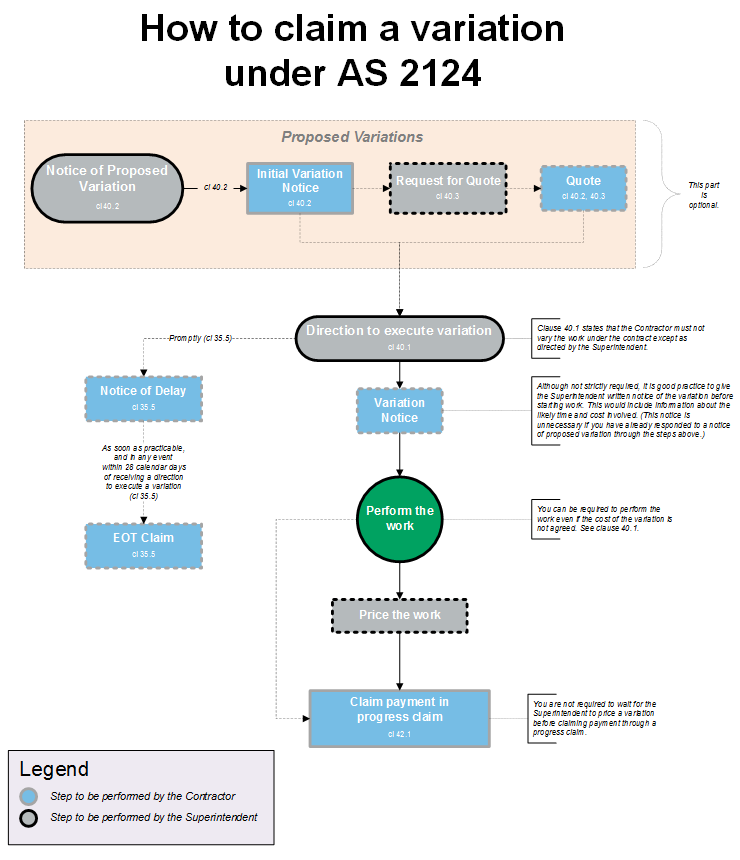This article explains how to claim a variation under AS 2124. It includes a flowchart to explain the process.

1. What is a variation under AS 2124?
A variation arises under AS 2124 when the superintendent directs the contractor to:
- increase, decrease or omit any part of the work under the contract;
- change the character or quality of any material or work under the contract;
- change the levels, lines, positions or dimensions of the work under the contract;
execute additional work; and/or - demolish or remove material or work no longer required by the principal. (See clause 40.1)
Importantly, latent conditions are dealt with separately under AS 2124. You can read about the process for claiming latent conditions here.
2. When can a variation be directed?
The contractor is not bound to execute a variation directed by the superintendent after the ‘date of practical completion’ unless the direction is in respect of defect rectification works.
Clause 40.1 also states that the contractor is only bound to execute a variation that is ‘within the general scope of the Contract’.
The general idea is that the superintendent cannot direct the contractor to perform a variation if it involves work that is entirely different to the type or extent of the work the contractor was originally engaged to perform, or if it is otherwise unable to be carried out under the provisions of the contract.
3. How does the variation process start under AS 2124?
The contractor must not carry out a variation unless directed by the superintendent or approved in writing by the superintendent under clause 40.
Relevantly, AS 2124 contemplates two types of direction.
The first is a direction relating to a proposed variation (under clause 40.2). This is not a direction to execute a variation. Rather, it is merely a request for an estimate (for costs and the effect on the construction program) in relation to a potential variation that may or may not be directed after receiving the contractor’s estimate. This is an optional step, as shown in the flowchart above.
The second is a direction to perform a variation (under clause 40.1). The superintendent is able to give this type of direction regardless of whether it has first given notice of a proposed variation (under clause 40.2).
4. How do you respond to a notice of proposed variation?
Clause 40.2 does not prescribe a time period by which the contractor must respond to a written notice of a proposed variation.
Your response should identify whether the variation can be effected. If it cannot be effected, you are not required to proceed with it.
Assuming the variation can be effected, your notice should set out your estimate of:
- the effect of the variation on the construction program;
- the effect of the variation on the date for practical completion; and
- the costs of carrying out the proposed variation, including delay costs.
Keep in mind that this initial response is simply intended to be an ‘estimate’. Detailed calculations or supporting information is not required at this stage.
If, after receiving your estimate, the superintendent requires more information, the superintendent may direct you to provide a detailed quotation of the work for a variation supported by measurements or other evidence of cost (under clause 40.3).
The last paragraph of clause 40.2 expressly entitles the contractor to claim reasonable costs of complying with the superintendent’s direction of a proposed variation, such as the costs of preparing an estimate or detailed quotation. If you wish to claim those costs, we suggest you include a statement to this effect in your response, identifying the amount you intend to claim and how the amount has been calculated.
5. Does a direction to execute a variation need to be in writing?
Arguably not – although as a matter of practice, it is always safest for there to be a written direction from the superintendent before starting work. This is principally to avoid the possibility of there being a dispute about the existence of a direction.
The contractual position is as follows:
Clause 40.1 empowers the superintendent to direct variations.
Clause 40.1 also prohibits the contractor from varying the work ‘except as directed by the superintendent or approved in writing by the superintendent under clause 40’. This wording suggests that variation directions by the superintendent need not be in writing. This stands in stark contrast to the equivalent provision in AS 4000 (clause 36.1), which you can read more about here.
Clause 23 expressly contemplates the possibility of directions being given by the superintendent both orally and in writing. Further, clause 23 obliges the contractor to comply with any direction given by the superintendent (provided the superintendent has power to give the direction under a clause of the contract).
Clause 23 goes on to state that, where the contractor requests (in writing) that the superintendent confirm an oral direction in writing, the contractor is not bound to comply with the request until the superintendent has done so.
If you start work on a variation without a written direction from the superintendent, you will need to be mindful of clause 46.1.
On one interpretation (and again, the clause is ambiguous), clause 46.1 could require you to give a ‘prescribed notice’ setting out your claim within 42 days of receiving the superintendent’s direction. The mandatory requirements of a ‘prescribed notice’ are set out in clause 46.1. If you have not issued a prescribed notice within that time frame, you are at risk of your claim being time barred. (You can read more about time bars here.)
6. What if the superintendent directs you to proceed without requesting a price?
Because the superintendent is not bound to issue a notice of a proposed variation before directing you to carry out a variation, it is theoretically possible that you could be required to carry out a variation without you having first given any indication as to the likely time or cost consequences.
As a matter of practice, we would suggest that you avoid this situation wherever possible.
Specifically, and although it is not strictly required under AS 2124 where the superintendent has not issued a notice of a proposed variation, we suggest before you start work on any variation, you make sure that you have given the superintendent a notice in writing that:
- identifies the work that you consider amounts to a variation;
- provides an indication as to the likely time and cost in carrying out the variation;
- includes a statement that you intend to claim for that cost; and
- either invites the superintendent to confirm the direction before proceeding (always the preferred approach), or states your intention to carry out the work unless the superintendent directs you to the contrary.
The purpose of this notice is to eliminate the possibility of the principal complaining, after the works have been performed, that it would not have ordered the variation had it known of the additional time and/or cost involved.
7. What should you have before starting work?
As explained above, by the time you have commenced work on the variation, there should be:
- a written direction from the superintendent to carry out the variation; and
- a notice in writing from you explaining the consequences of the variation.
Note that the price of the variation does not have to be agreed before you start work. The superintendent can require you to perform the variation and price the variation after the event.
Also note that, pursuant to clause 47.1, you are bound to continue performing your obligations under the contract notwithstanding the existence of a dispute. This would mean that you could be required to perform a variation even if there is a dispute about price.
8. How do you deal with delay?
Clause 35.5 of AS 2124 requires you to submit a notice of delay promptly after becoming aware of anything that may probably cause a delay to the work under the contract.
Consequently, if you are directed to:
- perform a variation; or
- stop work in anticipation of a variation,
you should consider giving a notice of delay if the variation or suspension is likely to affect your program.
If you require an extension of time for a variation, you must claim the extension within 28 calendar days of becoming aware of the cause of the delay (clause 35.5).
If a variation causes a delay, you will be entitled to claim delay costs (either under clause 36 or as part of the variation).
More information on how to give notices and make claims in relation to delays can be found here.
9. When can you claim payment for a variation?
In most cases, you will be entitled to claim payment for a variation through your regular progress claims. This applies regardless of whether the variation has been approved, and irrespective of whether the variation has been completed.
The security of payment legislation entitles you to claim payment for work performed. In most cases, this will include variations. Note that there can be exceptions, such as in Victoria (as we explain here).
If you disagree with the superintendent’s treatment of your claim, the security of payment legislation may provide an interim remedy. In any event, clause 47 of AS 2124 prescribes a method for resolving disputes.
10. Resources
You can download a print-friendly PDF version of the variation flowchart above by clicking here.
Read more about AS 2124 here.





